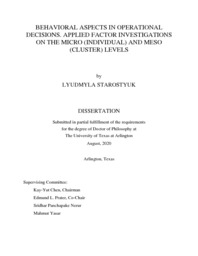
ATTENTION: The works hosted here are being migrated to a new repository that will consolidate resources, improve discoverability, and better show UTA's research impact on the global community. We will update authors as the migration progresses. Please see MavMatrix for more information.
Show simple item record
| dc.contributor.advisor | Chen, Kay-Yut | |
| dc.contributor.advisor | Prater, Edmund | |
| dc.creator | Starostyuk, Lyudmyla | |
| dc.date.accessioned | 2022-08-24T15:15:11Z | |
| dc.date.available | 2022-08-24T15:15:11Z | |
| dc.date.created | 2020-08 | |
| dc.date.issued | 2020-06-22 | |
| dc.date.submitted | August 2020 | |
| dc.identifier.uri | http://hdl.handle.net/10106/30863 | |
| dc.description.abstract | Normative theoretical models in operations management have been widely utilized by businesses and scientists to explain multiple phenomena. They assume that operating systems are managed by fully rational decision-makers who always choose the most profitable solution. However, decision-makers are human beings with behavioral and cognitive biases which influence their choices. In this thesis we argue that a change in the social and operating environments explains the choice deviation from the normative theoretical predictions. We present three independent studies of behavioral patterns on the individual and cluster levels. In the first study we observe the effect of human faces on the behavioral judgments in supply chain contracting. We find that the decisions made in “face” and “blind” settings are not equivalent. Judgments about facial attractiveness, trustworthiness and dominance influence the decision-maker in addition to the cognitive bias. We continue to explore the economic value of facial information in the second study. In experimental settings human faces are used as a facilitator of trust and honesty in a supply chain with multiple retailers competing for the cooperation of a single supplier. The analytical results reveal that retailer’s information sharing behavior and supplier’s reliance and reciprocity are influenced by the shown faces. Moreover, we observe that the channel efficiency improves when faces of all retailers are revealed to the supplier. However, the change in profitability is linked to the difference in facial trustworthiness. In the third study we use the data of terrorist attacks to investigate the behavioral patterns of organizations through their operational choices. We find that almost half of ideological terrorist movements connect through clusters. While some links have been stable over decades, the structure of the network has transformed from a centralized hierarchy to a decentralized structure and eventually evolved into the combination of two – a hybrid organization. Our findings suggest that the global terrorist network responses to the changes in operational environment by adopting the new structure. | |
| dc.format.mimetype | application/pdf | |
| dc.language.iso | en_US | |
| dc.subject | Newsvendor | |
| dc.subject | Face Effect | |
| dc.subject | Social Factors | |
| dc.subject | Behavioral Operations | |
| dc.subject | Trust and honesty | |
| dc.subject | Cheap talk | |
| dc.subject | Face effect | |
| dc.subject | Facial Trustworthiness | |
| dc.subject | Experimental economics | |
| dc.subject | Game theory | |
| dc.subject | Risk Management | |
| dc.subject | Crisis Management | |
| dc.subject | Terrorism | |
| dc.subject | Network Analysis | |
| dc.subject | Network Structure | |
| dc.subject | Terrorism Management | |
| dc.title | BEHAVIORAL ASPECTS IN OPERATIONAL DECISIONS. APPLIED FACTOR INVESTIGATIONS ON THE MICRO (INDIVIDUAL) AND MESO (CLUSTER) LEVELS | |
| dc.type | Thesis | |
| dc.degree.department | Information Systems and Operations Management | |
| dc.degree.name | Doctor of Philosophy in Management Science | |
| dc.date.updated | 2022-08-24T15:15:11Z | |
| thesis.degree.department | Information Systems and Operations Management | |
| thesis.degree.grantor | The University of Texas at Arlington | |
| thesis.degree.level | Doctoral | |
| thesis.degree.name | Doctor of Philosophy in Management Science | |
| dc.type.material | text | |
| dc.creator.orcid | 0000-0002-5903-4171 | |
Files in this item
- Name:
- STAROSTYUK-DISSERTATION-2020.pdf
- Size:
- 2.096Mb
- Format:
- PDF
This item appears in the following Collection(s)
Show simple item record


